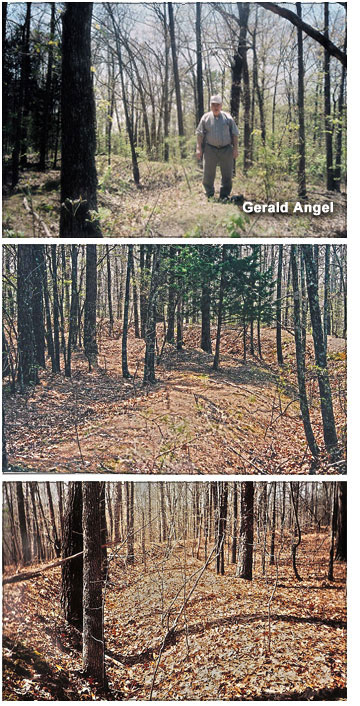
Fort Barnesville is one of two National Historic Sites in Reynolds County. It was placed on the National Register on July 1, 1998, based mainly on the work of Gerald Angel and those who assisted him. The fort lay undiscovered until local farmer Dan Massie came upon it in the 1950s at night on horseback. He told no one but his immediate family about the site. However, in 1995, after Dan’s son had married Gerald Angel’s daughter, the story of the unusual earthworks reached Gerald. From research done at Fort Benton at Patterson, Gerald recognized the formation as a fort. With the co-operation of the Missouri Department of Conservation, on whose land the fort is located, Gerald enlisted the help of Civil War historians, John Bradbury, Jerry Ponder and Joe Huett. Their inspection confirmed Gerald’s suspicion, but further research was needed to authenticate the fort. Two and one-half years of letter writing and research finally produced enough documentation to qualify the site for the National Register.
Fort Barnesville is classified as an earthen type redan fort in a horseshoe shape with two cannon pads and a powder magazine. It was named Barnesville because of its proximity to the town of Barnesville, now Ellington. A military trail through Barnesville, known as the Belleview Trail, Taum Sauk Trail, Poco Trail or Van Buren Trail ran from Pilot Knob, Missouri to Pocohontas, Arkansas. The trail came over Taum Sauk Mt., through Devil’s Toll Gate to Lesterville, through Centerville, south to Barnesville into Pine Valley and then to Van Buren. Both Union and Confederate troops used the trail.
Research showed the 13th Illinois Cavalry, which had helped with the construction of Fort Davidson, Fort Benton and at Bloomfield, camped at Barnesville during January through April, 1863. They are the likely builders of Fort Barnesville, possibly assisted by the 25th Missouri Infantry, known fort builders in the Corinth, Mississippi, area and present at the Barnesville location in early 1863. Searching the fort area with a metal detector located a brass buckle, later identified as a saber plate buckle, and a latch for a buckle. Draining and cleaning out the powder magazine produced no artifacts. Research continues in order to further document the construction of Fort Barnesville.
Access to Fort Barnesville is possible by vehicle, except during hunting seasons. See the map below. Additional information is available at the Museum in Ellington.
